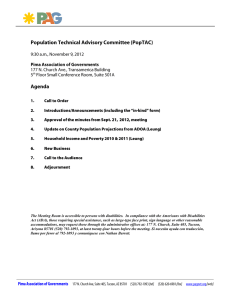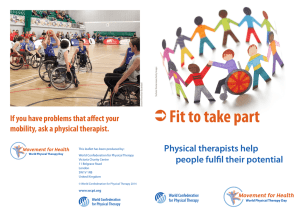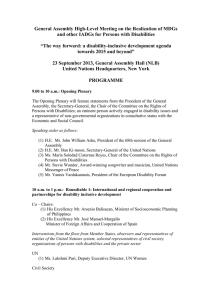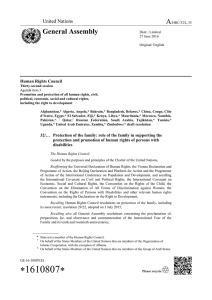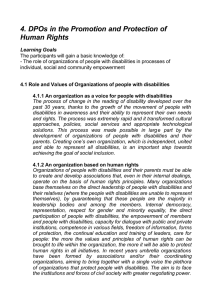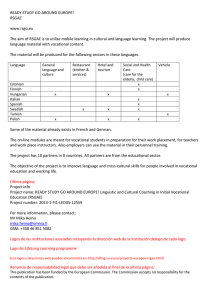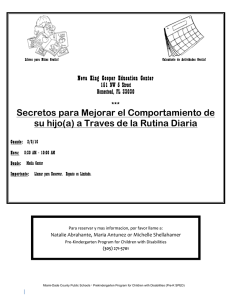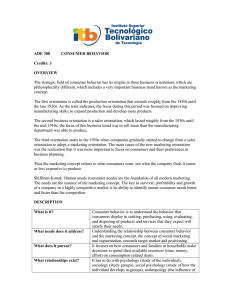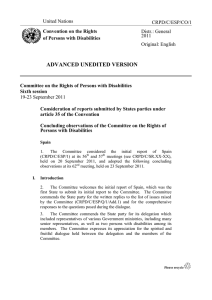Some indicators of satisfaction with the support system for students
Anuncio
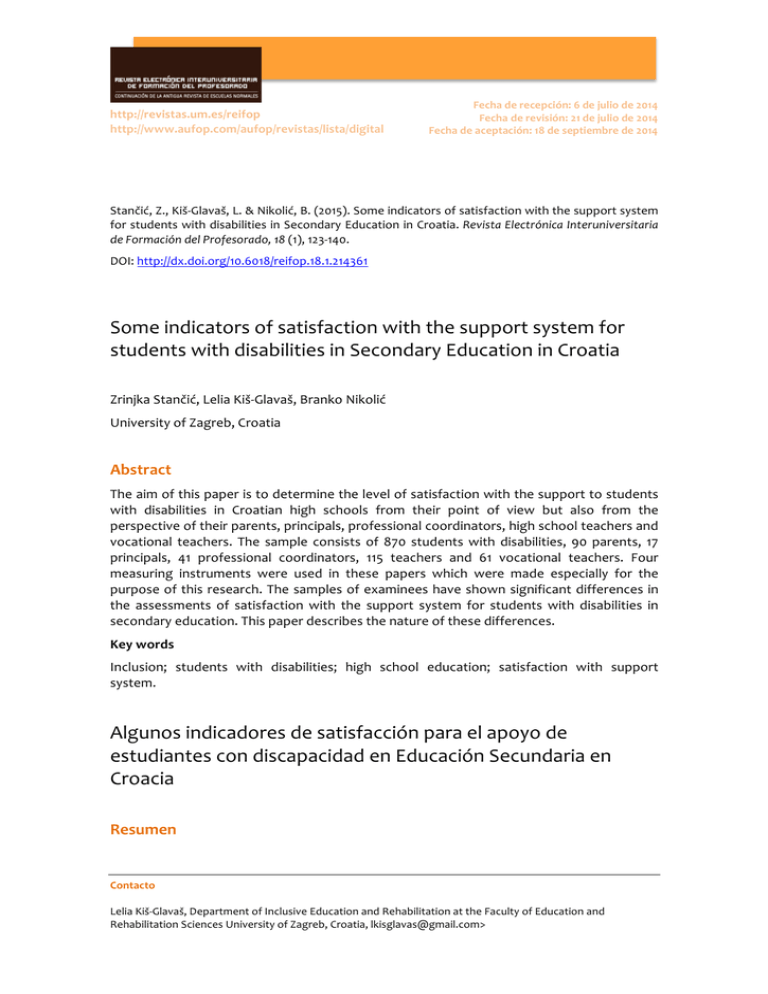
http://revistas.um.es/reifop http://www.aufop.com/aufop/revistas/lista/digital Fecha de recepción: 6 de julio de 2014 Fecha de revisión: 21 de julio de 2014 Fecha de aceptación: 18 de septiembre de 2014 Stančić, Z., Kiš-­‐Glavaš, L. & Nikolić, B. (2015). Some indicators of satisfaction with the support system for students with disabilities in Secondary Education in Croatia. Revista Electrónica Interuniversitaria de Formación del Profesorado, 18 (1), 123-­‐140. DOI: http://dx.doi.org/10.6018/reifop.18.1.214361 Some indicators of satisfaction with the support system for students with disabilities in Secondary Education in Croatia Zrinjka Stančić, Lelia Kiš-­‐Glavaš, Branko Nikolić University of Zagreb, Croatia Abstract The aim of this paper is to determine the level of satisfaction with the support to students with disabilities in Croatian high schools from their point of view but also from the perspective of their parents, principals, professional coordinators, high school teachers and vocational teachers. The sample consists of 870 students with disabilities, 90 parents, 17 principals, 41 professional coordinators, 115 teachers and 61 vocational teachers. Four measuring instruments were used in these papers which were made especially for the purpose of this research. The samples of examinees have shown significant differences in the assessments of satisfaction with the support system for students with disabilities in secondary education. This paper describes the nature of these differences. Key words Inclusion; students with disabilities; high school education; satisfaction with support system. Algunos indicadores de satisfacción para el apoyo de estudiantes con discapacidad en Educación Secundaria en Croacia Resumen Contacto Lelia Kiš-­‐Glavaš, Department of Inclusive Education and Rehabilitation at the Faculty of Education and Rehabilitation Sciences University of Zagreb, Croatia, [email protected]> Zrinjka Stančić, Lelia Kiš-­‐Glavaš, Branko Nikolić El objetivo de este trabajo es determinar el nivel de satisfacción del apoyo que reciben estudiantes con discapacidad en las escuelas croatas de educación secundaria desde su propio punto de vista, y también desde la perspectiva de sus padres, directores, coordinadores profesionales, profesores de secundaria y profesores de formación profesional. La muestra se compone de 870 estudiantes con discapacidad, 90 padres, 17 directores, 41 coordinadores profesionales, 115 profesores y 61 profesores de formación profesional. Para la recogida de datos se utilizaron cuatro instrumentos de medición, construidos especialmente para la investigación que se presenta. Los resultados muestran diferencias significativas en las evaluaciones de satisfacción con el sistema de apoyo para los estudiantes con discapacidad en la educación secundaria. En este trabajo se describe la naturaleza de estas diferencias. Palabras clave Inclusión; estudiantes con discapacidad; educación secundaria; satisfacción con el sistema de apoyo. Introducción The aim of secondary education, which is optional in Croatia, is aquairing general educational and vocational competencies, training for life and work in the changing socio-­‐ cultural context according to the requirements of a market economy, modern information and communication technologies, scientific achievements and training for lifelong learning (Act on Education in Primary and Secondary School, Official Gazette, 87/08). The Act explicitly states that primary and secondary education is based on the equality of educational opportunities for all students according to their abilities. High school students with disabilities, with the prescribed documentation, are entitled to enroll directly (Decision on the elements and criteria for selection of candidates for enrollment in the first year of high school in 2014/2015) in one of the three recommended programs for which the student received expert recommendation from the Croatian Employment Service, Department for vocational guidance. In that way students with disabilities who have completed primary school under the decision of the state administration office in the county i.e. the Zagreb City Office for Education, Culture and Sports, have the right to continue their education primarily in regular secondary schools under the same conditions, and only exceptionally in the schools with special programs. The rights of students with disabilities to adjustments in high school teaching and to adapted examination procedures are regulated by the Ordinance on the State Graduation Exam (Official Gazette, 97/08). According to the Article 65 of the Act on Education in Primary and Secondary Schools (Official Gazette, 87/08), and following the OECD classification, high school students with disabilities are: a) students with developmental disabilities, b) students with learning difficulties, behavioural problems and emotional problems, c) students whose difficulties are caused by educational, social, economic, cultural and linguistic factors. These difficulties can be caused by a variety of impairments and disabilities such as visual impairment, hearing impairment, disorders of the voice-­‐ language-­‐speech communication, motoric disorders and chronic diseases, reduced intellectual ability, attention deficit hyperactivity disorder, specific learning difficulties, behavioral problems and emotional disorders, autistic spectrum disorders and combined impairments and disorders. 124 Revista Electrónica Interuniversitaria de Formación del Profesorado (REIFOP) Algunos indicadores de satisfacción para el apoyo de estudiantes con discapacidad en Educación Secundaria en Croacia According to the Central Bureau of Statistics (Statistical Report, 1521) the Republic of Croatia had 440 secondary schools at the end of the school year 2009/2010 with a total of 183,039 students. Of 1074 students with disabilities in the full integration 7 of them are in gymnasiums, 102 in technical and related schools and 965 of them in industrial and commercial schools. It is interesting to point out that there are still 40 secondary schools for youth with disabilities in Croatia (15 special schools and 25 regular high schools that have special departments for children with disabilities). During school year 2012/2013 1681 students were educated according to special programs. Data at the end of 2010 show that the majority of students with disabilities in high schools is still educated in the conditions of so called partial integration. However, the latest data from the Ministry of Science, Education and Sports for school year 2013/2014 based on E-­‐Matica (digital form of the most important data about students) show the trend of changes aimed at increasing the number of students being educated in regular high schools. 1779 students are in the regular system and 1613 students are in schools or separate classes with special educational programs for ancillary occupations. Thirty years after educational inclusion was legalized in the Republic of Croatia, according to the presented data and to the series of assessments related to the children with disabilities, it is visible that their social integration is largely formal. Its successful implementation is difficult due to the lack of adequate support to parents and students, teachers, principals, professional assistants and peers (Kiš-­‐Glavaš, Ljubić, Jelić, 2003; Fulgosi-­‐Masnjak, Pintarić Mlinar, Sekušak-­‐Galešev, 2014; Kiš-­‐Glavaš, Cvitković; 2014, Žic Ralić, 2014; Igrić, 2014). In order to ensure inclusion in secondary education it is important to have efficient support of institutional bodies and services of vocational guidance as well as the social care services, legally supported mobile teams and teaching assistants, co-­‐operation between parents and schools (Igrić, Cvitković, Wagner Jakab, 2009; Igrić, Nikolić, Lisak, Rakić, 2010; Ivančić, Stančić, 2010; Stančić, Horvatić, Nikolić, 2011; Agency for mobility and EU programmes, 2012; Ivančić, Stančić, 2013). In the context of participatory research on this subject students with disabilities emphasize the importance of learning environment, taking into account individual needs, active participation of students as well as providing support from others (Krampač Grljušić, Žic Ralić, Lisak, 2010; Sekušak Galešev, Stančić, 2010; Martinov, 2013). In recent decades intensive work has been done with the aim of finding new ways to support inclusion in regular schools (Igrić, Kobetić, Lisak, 2008) based on the experiences of international and domestic practice (Haliwell, 2003, Igrić, Kobetić, Lisak, 2008). Croatian schools gradually introduce mobile professional teams and teaching assistans (Stančić, Sekušak-­‐Galešev, 2008; Kiš-­‐Glavaš, Cvitković, 2014). Above mentioned Act (Official Gazette, 87/08) stipulates that schools may, at the proposal of the founder, with the approval of the Ministry of Science, Education and Sports, engage other educational workers to meet the specific needs in the education and teaching process due to the specific conditions in schools. Also, Croatian National Educational Standard for Secondary Education (CNES) (Official Gazette, 63/08, 90/10) stipulates that school can provide teaching assistants, sign language interpreter and personal assistant to students who, according to the decision on the appropriate form of education, need help in learning, movement and school activities and tasks (The method of securing teaching assistants to students with disabilities in primary and secondary schools, the Ministry of Science, Education and Sports, 2014.) Unfortunately, Ordinance on primary and secondary education of students with disabilities (Ministry of Science, Education and Sports, 2014) which regulates the roles, duties and selection criteria and ways of financing an assistant in the classroom and mobile expert teams, and who has passed a public hearing in early spring last year, has not yet been Revista Electrónica Interuniversitaria de Formación del Profesorado (REIFOP) 125 Zrinjka Stančić, Lelia Kiš-­‐Glavaš, Branko Nikolić adopted, nor the Act on the Croatian Sign Language and other systems of communication of deaf and deafblind people in the Republic of Croatia (Ministry of Social Policy and Youth, 2014), which should regulate the issue of a sign language interpreter for deaf students. After thirty years of change in the education system based on scientific research in Croatia (Stančić, Mejovšek, 1982; Kiš-­‐Glavaš, Igrić, 1998; Igrić and assoc., 2001; Kiš-­‐Glavaš, Ljubić and Jelić, 2003; Ljubić, Kiš-­‐Glavaš, 2003; Igrić and assoc., 2008; Stančić and assoc., 2011; Međimurec and assoc., 2014, etc.) something that brings optimism is recently adopted Strategy for Education, Science and Technology of the Republic of Croatia (www.kvalifikacije.hr/fgs.axd?id=499), which as one of the goals states the development of a comprehensive support system for students. That implies the implementation of the aforementioned partially conducted measures of support to students with disabilities as well as the unification of the various support mechanisms within the educational institutions and outside of them. It also includes support during learning process, psychological support and career counselling as well as more specific forms of support for children and students with disabilities and gifted children and students. Research problem Despite many positive results and measures that were initiated so far, high school students with disabilities still face a number of problems that prevent them from having equal access to education and equal opportunities during their secondary education. Predictions are most often related to main characteristics of the satisfaction concept, e.g. sensitivity of principals and professional coordinators (psychologists, pedagogues) in schools, preparation of teachers and vocational teachers to provide appropriate support for students while ensuring adjustments in teaching, monitoring, evaluation and assessment of individual student's progress, availability of customized educational content, school equipment, availability of assistive technology, spatial accessibility in schools, customized transportation, etc. Taking into account the development of the inclusion process, it is important that all public institutions and organizations work together (Ministry of Science, Education and Sports, Agency for Vocational and Adult Education, Departments for Vocational Guidance, City Office of Education, Social welfare services, etc.). Local community with its resources and non-­‐governmental professional associations focused on inclusive education should also be included in this process. It is important to determine whether students with disabilities are satisfied with the support in secondary education and what is the level of satisfaction from the perspective of their parents, principals and professional staff. The findings from that research could be important guidelines for development and improvement of the support system in secondary education. Aim of the research The aim of this paper is to determine the level of satisfaction with the system that supports students with disabilities from their perspective and the perspective of their parents, principals, professional coordinators, high school teachers or vocational teachers in secondary education in Croatia. Also, the aim is to determine the differences among the samples of examinees and describe the nature of these differences. 126 Revista Electrónica Interuniversitaria de Formación del Profesorado (REIFOP) Algunos indicadores de satisfacción para el apoyo de estudiantes con discapacidad en Educación Secundaria en Croacia Methodology Research design and procedure The research, which is an integral part of this work, was carried out within the framework of the EU research project “The Multi-­‐Dimensional Analysis of Social Inclusion of Children and Students with Disabilities in Educational Process". Project was conducted by the Croatian Association of the Deaf-­‐Blind Persons ‘Dodir’ as part of the IPA 4 -­‐ Human Resources Development. We conducted a comprehensive analysis of the social inclusion of students with disabilities in secondary education in the Republic of Croatia in order to evaluate satisfaction, expectations and assessment of the current situation in schools from the perspective of students with disabilities, principals, professional coordinators, high school teachers, vocational teachers and students’ parents. This research examined the awareness of peers of students with disabilities and their parents. This is the first comprehensive study on the social inclusion of high school students with disabilities in Croatia. The research sample was collected in 32 secondary schools in Croatia listed at the Agency for Vocational and Adult Education of the Republic of Croatia. Based on the approval of the Ministry of Science, Education and Sports of the Republic of Croatian, the invitation to participate in the survey was sent to the 33 vocational high schools in Croatia since the largest number of typical students and students with disabilities is entitled to enrol in regular secondary vocational schools (with three-­‐year and four-­‐year vocational programs). Full consent of the principals and parents of minor students for participation in this research were obtained from 32 secondary schools. Participants Total sample of examinees who participated in research on satisfaction with the support system for students with disabilities in Republic of Croatia is shown in Table 1. Table 1. Number of examinees in the research Sample of Students examinees with disabilities Parents of students with disabilities N Sex 870 356 female students 90 49 mothers Principals and professional coordinators Teachers and vocational teachers Principals Professional Teachers Vocational coordinators teachers 17 41 115 61 37 women 135 women Sample of students with disabilities who participated in research is shown in Table 2. Revista Electrónica Interuniversitaria de Formación del Profesorado (REIFOP) 127 Zrinjka Stančić, Lelia Kiš-­‐Glavaš, Branko Nikolić Table 2. Some characteristics of students with disabilities considering the gender, success in school and type of disability Field Variables Form of education Success in school Type of disability f f% Individual specific procedure 487 56,0% Adapted program 114 13,1 % Special program 9 0,8 % Excellent Very good Good Sufficient Insufficient (failed) Visual impairment Hearing impairment Motoric disorders and chronic diseases Intellectual disabilities ADHD Specific learning difficulties Speech and language difficulties Behavioural disorders Autism Multiple difficulties/disorders 92 288 420 53 11 99 22 65 199 47 314 65 31 5 44 10,6% 33,1% 48,3 % 6,1% 1,3% 11,0 % 2,2% 7,5% 22,9% 5,4% 36,1% 7,5% 3,6% 0,57% 5,1% Other participants in this research are: a) Parents of students with disabilities (N=90) -­‐ 51 or 56,7% fathers; given the housing conditions 54.4% of parents live in their own home, 16 of them (17.8%) live in their own apartment, 18 with their parents and 6 of them as tenants. As for the educational structure, highest percentage of parents graduated from high school (5.6%), 13.3% of them have a university degree and 1 parent has a post-­‐graduate education. Most parents are employed (47%), 14.4% of them are retired. 58.9% of parents attended a lecture about students with disabilities. b) Principals (N=17) and professional coordinators (N=41) -­‐ 37 women; most experts (51 or 86.4%) are employed in vocational high schools, only 7 of them in mixed secondary schools. Given the size of the school, the majority of experts (37 or 62.7%) work in medium-­‐sized schools (with more than 500 students). The majority of professional staff are pedagogues (52), than psychologists (26), social pedagogues (7) education rehabilitators 4). According to the statements of 54% of examinees, there are 30 or more students with disabilities in schools where they work. Teaching assistants are included in only 6 high schools (10.2%) and only 5 schools use services of the mobile support teams. c) Teachers (N=115) and vocational teachers (N=61) -­‐ consists of 135 women (76,7%); 1 person teaches in gymnasium, 162 or 92,0% of them in vocational high schools. Given the program they are following 128 (72.7%) of them teach in regular programs and 90 (51.1%) in the classes under special programs. Almost all examinees (94.3%) indicated that they have at least one student with disabilities in their class. The structure of respondents according to years of service consists mainly of middle and younger generations of teachers (112 of them have up to 20 years of service). Most employees (81.8%) are employed for an indefinite period, 86.9% of them as full-­‐time employees. In response to questions about the 128 Revista Electrónica Interuniversitaria de Formación del Profesorado (REIFOP) Algunos indicadores de satisfacción para el apoyo de estudiantes con discapacidad en Educación Secundaria en Croacia professional development, 129 (73.3%) of them said that they have attended some lectures about students with disabilities. Instruments The research used four questionnaires which were all made for the purposes of this research. All questionnaires are composed of general information and statements aimed at the main research problem. Likert scale was used in all questionnaires. For each statement person can mark only one of the five options that indicate the level of agreement from 1 -­‐ strongly disagree to 5 -­‐ strongly agree, where higher values indicate a higher level of agreement. The following tests were included in the analyses: 1. Questionnaire on students’ satisfaction with the support system in secondary education (ZA-­‐ TES) is designed for students with disabilities and it consists of four parts. The first part of the Questionnaire consists of 11 questions related to general information (school name, school location, type of program, class, sex, age, place in which they live, type of housing, type of previous education programs, school performance of the previous class, type of disability). The second part consists of 9 statements and it examines satisfaction with the support system for students with disabilities in secondary education in the Republic of Croatia. The third part of the Questionnaire consists of 8 statements and it examines the expectations towards the system of support to students with disabilities. The fourth part consists of 8 substantially same statements and it evaluates the current situation at the school the student attends. For research purposes Questionnaire is linguistically simplified. 2. Questionnaire on satisfaction of parents of the students with disabilities (ZA-­‐RTES) consists of four parts. The first part of the Questionnaire consists of 8 questions related to general information (school name, school location, class, sex, type of housing, level of education, type of employment, lectures on students with disabilities). The second part consists of 9 statements and it examines satisfaction with the support system for students with disabilities in secondary education. The third part of the questionnaire consists of 13 statements and it examines the expectations towards the system of support for students with disabilities. The the fourth part consists of 13 substantially same statements and it evaluates the current situation at their child’s school. 3. Questionnaire on satisfaction of principals and professional coordinators (ZA-­‐TESS) consists of four parts. The first part of the Questionnaire consists of 16 questions related to general information (school name, school location, type of the school, type of the program position in school, sex, total number of students, number of students with disabilities, total number of teachers and vocational teachers, number and profile of professional coordinators, number of teaching assistants, coordinators, services of the professional mobile team, other services). Other parts of the Questionnaire are identical to the ones in the Questionnaire for parents. 4. Questionnaire on satisfaction of teachers and vocational teachers (ZA-­‐NSU) is designed for teachers and vocational teachers and it consists of four parts. The first part of the Questionnaire consists of 12 questions related to general information (school name, school location, type of the school, type of the program position in school, program, sex, number of students with disabilities, years of service, employment, working hours, lectures on students with disabilities). Other parts of the Questionnaire are identical to the ones in the Questionnaires for parents and principals. The reliability of all the instruments was assessed by the Cronbach's alpha model and it was high in all (above 0.80). Revista Electrónica Interuniversitaria de Formación del Profesorado (REIFOP) 129 Zrinjka Stančić, Lelia Kiš-­‐Glavaš, Branko Nikolić Data Analysis Descriptive methods were used in data processing which includes calculating the mean, standard deviations, minimum and maximum results and the average scores according to Likert scale (categories 1-­‐5). Kolmogorov-­‐Smirnov test was used to test the normality of frequency distribution of some variables in the satisfaction scale. Results were shown in tables and charts. In order to test the differences, one–way analysis of variance (ANOVA) was used to process the results. Levene’s test for homogeneity of variances was used for determining the differences between the variances and Brown-­‐Forsythe robust test of equality of arithmetic means was used when variances were different (non-­‐homogeneous). Comparison of arithmetic means of individual groups of respondents was carried out using POST HOC analysis according to Turkey HSD. Statistical package SPSS 17.0 was used for data processing. Results and Discussion Level of satisfaction with the support system for the participants in the secondary education In accordance with the purpose of this research, the aim was to determine the level of satisfaction of certain groups of participants in secondary inclusive education with the support system for students with disabilities. It will enable better insight into the determinants of satisfaction for inclusive support in schools (Stančić, 2014). Table 3 Results of the analysis on the summed variables of the scale of satisfaction with the support system for students with disabilities in secondary education Examinees Students with disabilities Principals and professional coordinators Teachers and vocational teachers Parents of students with disabilities M SD MIN MAX 31,80 27,92 8,27 5,98 9 17 45 38 Average results according to scale of satisfaction 1-­‐5 3,53 3,10 26,82 6,32 11 45 2,98 30,93 8,82 9 45 3,44 Note: (N) number of participants, (M) arithmetic mean, (SD) standard deviation Review of the overall results of respondents on a scale of satisfaction (Table 3) shows that students with disabilities show the largest average satisfaction with the support system and that is 31.80, which corresponds to an average assessment 3.53; then the parents of students with disabilities with an average score of 30.93, which corresponds to an average assessment 3.44; then the principals and professional coordinators with an average score of 27.92, which corresponds to the average grade 3.10, and the lowest average satisfaction is expressed by teachers and vocational teachers whose score is 26.82, which corresponds to the average grade 2.98. Students with disabilities have expressed moderate satisfaction with the statement "I mostly agree"; parents of children with disabilities showed a medium 130 Revista Electrónica Interuniversitaria de Formación del Profesorado (REIFOP) Algunos indicadores de satisfacción para el apoyo de estudiantes con discapacidad en Educación Secundaria en Croacia or partial satisfaction ("neither agree nor disagree"); principals and professional coordinators in schools also expressed satisfaction with the support system for students with disabilities in secondary education ("neither agree nor disagree"). Lower level of satisfaction was displayed by teachers and vocational teachers whose results also belong to the category of medium satisfaction ("neither agree nor disagree") but with a lower level than other groups. A range of results goes from the theoretical minimum, which means that there are students with disabilities and their parents who are very dissatisfied with the system of support to the theoretical maximum, which also shows that there are students and parents of students with disabilities who are fully satisfied with the system of support in secondary education in the Republic of Croatia. Principals and professional coordinators were more mutually aligned in assessing the satisfaction and they are not completely dissatisfied and nor fully satisfied with the support system. After examining the results, it is possible to determine that the total score for teachers and vocational teachers is very close (just under) partial satisfaction and therefore it is possible to conclude that they are neither satisfied nor dissatisfied with the support system for students with disabilities in secondary education. Their mutual agreement about this result is not harmonized so there are teachers and vocational teachers who are almost totally dissatisfied and those who are completely satisfied with the support system. There is an interesting difference in the average satisfaction of participants in inclusive secondary education with the support system for students with disabilities. Satisfaction of students and their parents is not high but it exists. Lower level of satisfaction of principals and professional coordinators and especially dissatisfaction of teachers and vocational teachers most certainly speaks of the difficult conditions in which they implement inclusive education and support system for the students, with the aim of meeting the needs of students and their parents. Kolmogorov-­‐Smirnov test for normality of distribution of frequency results in individual variables of the Satisfaction scale showed that all empirical distributions do not differ significantly from the normal distribution, except for the assessment of teachers and vocational teachers in statement ZAD-­‐06 („I am satisfied with the forms of cooperation between professional coordinators and teachers which are focused on students with disabilities”). It should be noted that teachers and vocational teachers (176 of them) come from 32 high schools, 27 of which are vocational schools from all over Croatia. With regard to different profiles of experts in schools, forms of cooperation with each other are quite different so it is possible to explain the fact that the distribution of the results of this variable is not normal. The results of descriptive analysis for each group of respondents are presented below and the basic statistics for each variables of the satisfaction scale are shown in Table 4 and Picture 1. Analysis of the results in Table 4 shows that the arithmetic mean of all groups of respondents is mainly around theoretical middle (3), and in some groups above middle, i.e. above the average result 3. As for the estimates that indicate dissatisfaction with the support system, they show that students with disabilities are not fully dissatisfied (all average grades above 2.5). Group of principals and professional coordinators was divided in 4 particles that describe their partial dissatisfaction and they are related to the offer of education programs for students with disabilities (ZAD-­‐01), the work of institutional bodies and services (e.g. Department of Education, Office of Vocational Guidance) (ZAD-­‐05), special educational equipment in Revista Electrónica Interuniversitaria de Formación del Profesorado (REIFOP) 131 Zrinjka Stančić, Lelia Kiš-­‐Glavaš, Branko Nikolić schools (ZAD-­‐07) and additional education for working with students with disabilities included in secondary school curricula (ZAD-­‐08). Table 4 Basic statistical indicators Variables ZAD-­‐01 ZAD-­‐02 ZAD-­‐03 ZAD-­‐04 ZAD-­‐05 ZAD-­‐06 ZAD-­‐07 ZAD-­‐08 ZAD-­‐09 Total satisfaction SEN 3,69 3,69 3,78 3,79 3,51 3,09 2,96 3,52 3,78 31,80 Mean RSS NSU 2,81 2,79 3,07 3,09 3,12 2,72 3,41 2,99 2,78 2,66 3,88 4,05 2,71 2,46 2,59 2,66 3,54 3,40 27,92 26,82 SD R-­‐SEN 3,39 3,20 3,52 3,66 3,29 3,56 3,17 3,32 3,83 30,93 SEN 1,28 1,22 1,23 1,22 1,36 1,50 1,43 1,37 1,32 8,27 RSS 0,92 0,94 0,91 0,97 1,04 0,81 1,08 0,89 0,90 5,98 NSU 1,15 1,02 1,13 1,11 1,03 0,90 1,16 1,02 0,87 6,32 R-­‐SEN 1,29 1,33 1,19 1,22 1,25 1,24 1,30 1,20 1,18 8,82 MIN 1 1 1 1 1 1 1 1 1 9 MAX 5 5 5 5 5 5 5 5 5 45 Note: SEN-­‐students with disabilities, RSS-­‐ principals and professional coordinators, NSU-­‐ teachers and vocational teachers, R-­‐SEN-­‐ parents of students with disabilities Partial dissatisfaction of teachers and vocational teachers applies even to six of the nine areas of assessment such as offer of education programs for students with disabilities (ZAD-­‐01), ability to work with students with disabilities (ZAD-­‐03), ability to adjust to specific student’s needs during examination (e.g. oral or written examination, questions for repetition etc.) (ZAD-­‐04), institutionalized support to schools (ZAD-­‐05), special educational equipment in schools (ZAD-­‐07) and additional education (ZAD-­‐08). Parents of students with disabilities show partial and moderate satisfaction in all particles related to support assessment. According to lower estimates of respondents, it can be concluded that certain forms of support for students with disabilities in secondary education are insufficiently aligned with their expectations and needs, and/or are not implemented in an appropriate way or they are not good enough. Results indicate the factors of changes that are crucial for the advancement of inclusive quality from the perspective of individual participants in education, e.g. ensuring appropriate housing in dormitory for those students whose school is not in the same city where they were born and where their families live. It is important that professionals in schools are willing to acquire additional knowledge that is essential for the advancement of their professional competences. A disturbing fact is that teachers and vocational teachers show dissatisfaction with their preparation for work with students with disabilities and for the work in the context of inclusive education (Ivančić, Stančić, 2010; Pastuović, 2013; Ivančić, Stančić, 2013). In order to ensure inclusion in education, according to the results of this study, it is necessary to establish effective support of the institutions and services, continuous training of teaching staff, better equipment in schools and in particular enrichment of high school program in which students with disabilities can achieve their professional interests and become well prepared for the work and/or further education. The findings in this study are consistent with findings in some previous studies in Croatia (Kiš-­‐Glavaš, 1999; Kiš-­‐Glavaš, Ljubić, Jelić, 2003; Ljubić, Kiš-­‐Glavaš, 2003; Međimurec Grgurić i assoc., 2014) which also points to some faults in inclusive education. Illustration of the assessment of satisfaction with the forms of support according to the groups of examinees can be seen in Picture 1. 132 Revista Electrónica Interuniversitaria de Formación del Profesorado (REIFOP) Algunos indicadores de satisfacción para el apoyo de estudiantes con discapacidad en Educación Secundaria en Croacia Picture 1 Average values of the evaluation results on satisfaction scale according to specific items The differences between means of the results of all respondents were calculated and shown in Table 5. Table 5 Differences in arithmetic mean on the individual and total variables of satisfaction among groups of subjects Variables ZAD-­‐01 ZAD-­‐02 ZAD-­‐03 ZAD-­‐04 ZAD-­‐05 ZAD-­‐06 ZAD-­‐07 ZAD-­‐08 ZAD-­‐09 Total satisfaction TTest of Homogeneity of Variances Levene's Sig. test 5,57 0,001 8,87 0,000 5,35 0,001 1,97 0,116 13,70 0,000 43,61 0,000 4,13 0,006 18,39 0,000 18,32 0,000 6,39 0,000 One –way analysis of variance (ANOVA) F test Sig. 32,29 18,57 41,09 22,74 24,74 29,01 8,00 28,47 5,10 21,82 0,000 0,000 0,000 0,000 0,000 0,000 0,000 0,000 0,000 0,000 Robust Tests of Equality of Means Brown-­‐ Sig. Forsythe 38,53 0,000 21,00 0,000 49,42 0,000 26,02 0,000 32,07 0,000 49,23 0,000 10,28 0,000 40,92 0,000 7,35 0,000 26,13 0,000 Note: (Sig) significance For all variables of satisfaction F test is statistically significant because all=0,000. It means the ANOVA has shown there are statistically significant differences in arithmetic mean of individual and total variable of satisfaction between students with disabilities, principals and professional coordinators, teachers and vocational teachers and parents of students with disabilities. However, Levine’s test shows that all satisfaction variables have different variances (Sig.=0,000) except ZAD-­‐04, where variances are the same because Sig.=0,116 which means it is over 5%. For all variables, except ZAD-­‐04, it is necessary to calculate and Revista Electrónica Interuniversitaria de Formación del Profesorado (REIFOP) 133 Zrinjka Stančić, Lelia Kiš-­‐Glavaš, Branko Nikolić interpret the Brown-­‐Forsythe robust tests of equality of means. Since the results of this test showed that all the Sig. <5%, it can be concluded that there is a statistically significant difference between mean values of results between students with disabilities, principals and professional coordinators, teachers and vocational teachers and parents of students with disabilities at the level of relevance Sig=0,000. The nature of these differences can be described with the results of comparisons of arithmetic means of individual groups of respondents using the POST HOC analysis according to Turkey HSD. The results are shown in Table 6. Table 6 Comparison of arithmetic means of individual and total variable of satisfaction between groups of examinees Variables ZAD-­‐01 ZAD-­‐02 ZAD-­‐03 ZAD-­‐04 ZAD-­‐05 ZAD-­‐06 ZAD-­‐07 ZAD-­‐08 ZAD-­‐09 SUM satisfaction SEN-­‐RSS S S S S N S S S S S SEN-­‐NSU S S S S S S S S S S Differences in arithmetic mean SEN-­‐R-­‐SEN RSS-­‐NSU RSS-­‐R-­‐SEN N N S S N N N N N N N N N N N N N N S N N N N N N N S N N N NSU-­‐R-­‐SEN S N S N S S S S S S Note: S-­‐significant (<5%); N-­‐non significant (>5%) The analysis of the significance of differences shown in Table 6 and their comparison and arithmetic mean shown in Table 4 it is visible that most often there are significant differences between the results of the assessment of satisfaction with the support system for students with disabilities in secondary education between students with disabilities and principals and professional coordinators; students with disabilities and teachers and vocational teachers as well as the teachers and vocational teachers and parents of students with disabilities. Students with disabilities are generally more satisfied with the support system than principals and professional coordinators in almost all variables of the satisfaction scale. Only exception is the variable related to the satisfaction with the special educational equipment in schools (ZAD-­‐05) where there is no significant difference between groups. Students were more satisfied with the offer of education programs for students with disabilities, availability of information on possibility of enrollement and education, adjustments in teaching process (eg. methods of work, summaries for learning) for students with disabilities, adjustments to student’s needs during examination (eg. oral or written examination, questions for repetition etc.), organized transportation for students with disabilities, organization of social activities for students with disabilities and other student of the school, housing arrangements in student’s dormitories, and ways of providing support in studying. Students with disabilities are also more satisfied with the support system than teachers and vocational teachers, in general and in all variable of the satisfaction scale. This is important information for teachers and vocational teachers and they should be informed about it 134 Revista Electrónica Interuniversitaria de Formación del Profesorado (REIFOP) Algunos indicadores de satisfacción para el apoyo de estudiantes con discapacidad en Educación Secundaria en Croacia because their motivation for teaching could be enhanced by the fact that students appreciate their efforts. Parents of students with disabilities are more satisfied with the support system for thier children than teachers and vocational teachers. It is visible form the general results of the scale but also from the individual variables. Only exception is variable ZAD-­‐06 („I am satisfied with the forms of cooperation between professional coordinators and teachers which are focused on students with disabilities”) where teachers and vocational teachers show higher level of satisfaction (which indicates the positive perception of cooperation between professional coordinators and teachers -­‐ from the teachers' perspective). In variables ZAD-­‐02 („I am satisfied with the availability of information on possibility of enrollement and education for students with disabilities“) and ZAD-­‐04 („I am satisfied with adjustments to student’s needs during examination, eg. oral or written examination, questions for repetition etc.), there is no statistically significant difference in the level of satisfaction between these 2 groups of examinees. Although there are no significant differences in the level of satisfaction of students with disabilities and their parents with the support system, such difference exists in variables ZAD-­‐02 („I am satisfied with the availability of information on possibility of enrollement and education for students with disabilities“) where student expressed more satisfaction than their parents and ZAD-­‐07 which is related to housing arrangements of students with disabilities in student’s dormitories and which indicates that parents are more satisfied with accommodation than their children. Also, there is no statistically significant difference in the total score on a scale of satisfaction between principals and professional coordinators and parents of students with disabilities but there are some differences in variables ZAD-­‐01 („I am satisfied with the offer of high school education programs for students with disabilities“) and ZAD-­‐09 („I am satisfied with the forms of support to students with disabilities“) where parents show significantly higher level of satisfaction than principals and professional coordinators. Regardless of these findings, it should be emphasized that principals and professional coordinators as well as the parents should work together in order to achieve inclusion (Ivančić, 2012). On that path, professional coordinators are in charge of mediation, principals are managers and parents are the ones who know best the needs of their children. Finally, although there are no statistically significant differences in the total score on a satisfaction scale and there are no such differences on either of the variables of the scale, it is therefore interesting to see the high level of stacking in overall satisfaction and satisfaction with specific forms of support in secondary education between principals and professional coordinators and teachers and vocational teachers in Croatian high schools. It seems that all the professionals involved in the system of secondary education are homogenized in their assessment of satisfaction or dissatisfaction with the support system to students with disabilities in secondary education. It is time that we consider their assessment and act accordingly in order to increase their satisfaction which would certainly increase the quality of secondary education for students with disabilities, and thus for the other participants of inclusive education. Results of this research can be associated with the previous research done by Booth and Ainscow (2002) and Mantalut and Rukhadz (2008) who write about mutual cooperation of teachers, principals, parents and students with disabilities themselves. Key words from that research are focused on inclusion, barriers to learning and resources to create an inclusive culture, policies and practices. If we compare it with this research, we can notice that the system provides different forms of support to students involved in the education system, Revista Electrónica Interuniversitaria de Formación del Profesorado (REIFOP) 135 Zrinjka Stančić, Lelia Kiš-­‐Glavaš, Branko Nikolić depending on their individual needs. That support includes resources (mobile teams, assistants, institutional support, etc.) and support for learning and evaluating student’s achievements with the mandatory participation of parents and cooperation of experts and parents who are all focused on their well-­‐being and providing the best education for them. Our aim should be the satisfaction of all participants in the inclusive education with the support system. The results presented in this paper indicate that students and parents are more satisfied with some aspects of support, precisely with the ones that principals and professional coordinators and especially teachers and vocational teachers refer to as not good enough (offer of the education programs, school equipment, workshops for developing new competencies). This last statement is very important for teachers and vocational teachers and also to professional coordinators because developing competencies for working in inclusive education includes new working methods and new ways of evaluation students' achievements in secondary education. It is also important to expand the offer of education programs as well as the financial resources for that purposes (Mattes, 2007, according to McNamara, O'Hara, 2008) in order to provide better education for all students. And finally, in order to successfully meet the needs of students with disabilities, it is important that all participants of the educational process work together. Conclusion The contributions of this research to better understanding of inclusive education are both theoretical and practical. Although the process of integration of students with disabilities in the Republic of Croatia is a long process, inclusion and inclusiveness as culture (Ivancic, Stancic, 2013) has not yet been sufficiently incorporated in Croatian schools. The intention was to identify some factors of quality in secondary education of students with disabilities and this paper presents some parts of that research. In order to raise the quality of the inclusive approach in the education system (Kekez Koštro, Kekez, 2014, Stančić, 2014), the aim of this study was to determine the indicators of satisfaction with the support system for students with disabilities in high schools. The obtained data indicate the need for further improvement of the process and the development of inclusive standards in secondary education in the Republic of Croatia. References Act on the Croatian Sign Language and other systems of communication of deaf and deaf-­‐ blind people in the Republic of Croatia http://www.mspm.hr/novosti/vijesti/javna_rasprava_o_nacrtu_prijedloga_zakona_o _hrvatskom_znakovnom_jeziku_i_ostalim_sustavima_komunikacije_gluhih_i_gluho slijepih_osoba_u_republici_hrvatskoj. Act on Education in Primary and Secondary Schools, Official Gazette 87/2008, 6/2009, 92/2010, 105/2010, 90/2011, 5/2012, 16/2012, 86/2012, 126/2012, 94/2013. Agency for mobility and EU Programmes (2012). Kojim putem krenuti. Publikacija o profesionalnom usmjeravanju u Republici Hrvatskoj. Zagreb: Intergrafika. Booth, T. Ainscow M. (2002). Index for Inclusion: Developing learning and participation in schools, CSIE, New Redland Building, Coldharbour lane, Frenchay, Bristol BS16 1 QU, UK. 136 Revista Electrónica Interuniversitaria de Formación del Profesorado (REIFOP) Algunos indicadores de satisfacción para el apoyo de estudiantes con discapacidad en Educación Secundaria en Croacia Croatian Bureau of Statistics, Statistical reports, NO. 1521, Srednje škole i učenički domovi kraj šk. g. 2012./2013. i početak šk. g. 2013./2014., ISSN 1332-­‐1862. Croatian National Educational Standard for Secondary Education (Official Gazette, No. 63/2008, 90/2010). Decision on the elements and criteria for selection of candidates for enrollment in the first year of high school in 2014/2015., Official Gazette 54/2014. Fulgosi-­‐Masnjak, R., Pintarić Mlinar, Lj., Sekušak-­‐Galešev, S. (2014). Razvojne teškoće u odgoju i obrazovanju, In: Igrić, Lj., Fulgosi-­‐Masnjak, R., Wagner Jakab, A. (ed.). Učenik s teškoćama između škole i obitelji, Center for Inclusive Support IDEM, Zagreb, pp. 7-­‐21. Haliwell, M. (2003). Supporting children with special educational needs, A guide for assistants in schools and pre-­‐schools, London: David Fulton Publishers. Igrić, Lj. (2014), Roditelji i djeca s teškoćama, In: Igrić, Lj., Fulgosi-­‐Masnjak, R., Wagner Jakab, A. (ed.). Učenik s teškoćama između škole i obitelji, Center for inclusive support IDEM, Zagreb, pp. 60-­‐73. Igrić, Lj., Cvitković, D., Wagner Jakab, A. (2009). Djeca s teškoćama u interaktivnom sustavu obitelj-­‐škola-­‐vršnjaci, Croatian Review of Rehabilitation Research, 45, 1, 31-­‐38. Igrić, Lj., Kobetić, D., Lisak, N. (2008). Evaluacija nekih oblika podrške edukacijskom uključivanju učenika s posebnim potrebama. Dijete i društvo, Magazine for promotion the rights of the children, 10, 1/2, 179-­‐197. Igrić, Lj., Nikolić, B., Lisak, N., Rakić, V. (2010). Ispitivanje nekih čimbenika uže okoline za razvoj tolerancije prema djeci s teškoćama. Magazine for promotion the rights of the children, 12, 1/2, 19-­‐38. Ivančić, Đ. (2012). Pokazatelji kvalitete inkluzivne škole. Doctoral thesis, Faculty of Education and Rehabilitation Sciences University of Zagreb. Ivančić, Đ., Stančić, Z. (2013). Stvaranje inkluzivne kulture škole, Croatian Review of Rehabilitation Research 49, 2, 139-­‐157. Ivančić, Đ., Stančić, Z. (2010). Podrškom učiteljima do bolje uspješnosti učenika s teškoćama. In: Đurek, V. (ed): Collection of scientific papers Uključivanje i podrška u zajednici“, 8th International Congress of the Croatian Association of Education Rehabilitators (pp. 159-­‐169), 22.-­‐24.04.2010., Varaždin: Školska knjiga, Zagreb. Kekez Koštro, A., Kekez, M. (2014). I ja želim učiti, Zagreb, Croatian Association of the Deaf-­‐ Blind Persons ‘Dodir’, Zagreb, ITG d.o.o., 3-­‐22. Kiš-­‐Glavaš, L. (1999): Promjena stava učitelja prema integraciji djece usporenog kognitivnog razvoja, Doctoral Thesis, Univeristy of Zagreb, Faculty of defectology, Zagreb. Kiš-­‐Glavaš, L., Cvitković, D. (2014). Učitelji i edukacijsko uključivanje, In: Igrić, Lj., Fulgosi-­‐ Masnjak, R., Wagner Jakab, A. (ed.). Učenik s teškoćama između škole i obitelji, Center for Inclusive Support IDEM, Zagreb, pp. 28-­‐40. Kiš-­‐Glavaš, L., Igrić, Lj. (1998). Stavovi prema učenicima usporenog kognitivnog razvoja i kako ih mijenjati. Collection of scientific papers from the International Scientific Colloquium Kvaliteta u odgoju i obrazovanju“, 19.-­‐20.02.1998., Faculty of Humanities and Social Sciences, Rijeka, 374-­‐384. Revista Electrónica Interuniversitaria de Formación del Profesorado (REIFOP) 137 Zrinjka Stančić, Lelia Kiš-­‐Glavaš, Branko Nikolić Kiš-­‐Glavaš, L., Ljubić, M. and Jelić, S. (2003). Stavovi ravnatelja srednjih škola prema edukacijskoj integraciji. Magazine for promotion the rights of the children, 39, 2, 137-­‐ 146. Krampač Grljušić, A., Žic Ralić, A., Lisak, N. (2010). Što djeca s teškoćama misle o podršci asistenta u nastavi. Collection of scientific papers “Uključivanje i podrška u zajednici“, 8th International Congress of the Croatian Association of Education Rehabilitators (pp. 181-­‐194), Đurek, V. (ed), 22.-­‐24.04.2010, Varaždin: Školska knjiga, Zagreb. Ljubić, M., Kiš-­‐Glavaš, L. (2003). Razlike u stavovima nastavnika osnovnih i srednjih škola prema edukacijskoj integraciji. Croatian Review of Rehabilitation Research 39, Vol. 2, 129-­‐136. Mantaluta, O., Rukhadze, N. (2008). Economic model cost-­‐satisfaction in inclusive Education. Based on research made in Georgia. Journal of Applied Quantitative Methods, 3, 4, 352-­‐365. Martinov, M. (2013). Samoprocjena učenice i plan podrške. Master thesis. Faculty of Education and Rehabilitation Sciences, University of Zagreb. Mc Namara, G., O'Hara, J. (2008). The importance oft he concept of selfevalution in the changing landscape of education policy. IN: Studies in Educational Evaluation 34, 3, 173-­‐179. Međimurec Grgurić, P., Vlah, N., Baftiri, Đ., Martinić, T., Šaka, D (2014). Stavovi nastavnika srednjih strukovnih škola o integraciji učenika s intelektualnim teškoćama, specifičnim teškoćama učenja, problemima u ponašanju i ADHD-­‐om. Collection of scientific papers „Poticajno okruženje za cjeloživotno učenje“, 10th Congress of the Croatian Association of Education Rehabilitators (pp. 34-­‐49), Žic Ralić, A., Bukvić, Z. (ed), 24.-­‐25.04.2014., Varaždin: Školska knjiga. Ordinance on primary and secondary education of students with disabilities, Ministry of Science, Education and Sport, http://public.mzos.hr/Default.aspx?art=12311&sec=1933. Ordinance on the State Graduation Exam, Official Gazette 97/2008. Pastuović, N., Obrazovanje i razvoj, Zagreb, 2013, Institute for Social Research. Sekušak-­‐Galešev, S., Stančić, Z. (2010). Samozavedanje in stališća učencev s težavami pri učenju do pomembnih oseb v inkluzivnem izobraževanju. Zbornik pripevkov tretje mednarodne konferenca o specifičnih učnih težavah v Sloveniji in nacionalna konferenca Tempus-­‐iSheed „Specifične učne težave v sveh obdobjih, (pp. 31-­‐46), Košak-­‐Babuder, M., Kavkler, M., Magajna, L., Pulec, Lah, A., Stančić, Z., Clement Morrison, A. (ed.), 1-­‐2.11.2010, Ljubljana: Faculty of Education, University of Ljubljana. Stančić, Z. (2014). Multidimenzionalna analiza socijalne uključenosti učenika s teškoćama u srednjoškolskom obrazovanju. In: Multidimenzionalna analiza socijalne uključenosti djece s teškoćama i studenata s invaliditetom, Zagreb, Croatian Association of the Deaf-­‐Blind Persons ‘Dodir’, 6-­‐20. Stančić, V., Mejovšek, M. (1982). Stavovi nastavnika redovnih osnovnih škola prema odgojno-­‐ obrazovnoj integraciji djece sa smetnjama u razvoju, Faculty of Defectology, Zagreb. Stančić, Z., Horvatić, S., Nikolić, B. (2011). Neki aspekti percipirane kompetencije za ulogu učitelja u inkluzivnoj školi. In: Jurčević Lozančić, A., Opić, S. (ed): Škola, odgoj i učenja za budućnost (pp. 343-­‐354), Zagreb: Faculty of Teacher Education, University of Zagreb. 138 Revista Electrónica Interuniversitaria de Formación del Profesorado (REIFOP) Algunos indicadores de satisfacción para el apoyo de estudiantes con discapacidad en Educación Secundaria en Croacia Stančić, Z., Sekušak, Galešev, S. (2008). Asistenti u nastavi -­‐ što o njihovom uključivanju misle učitelji i defektolozi učitelji. www.azoo.hr Strategy for Education, Science and Technology of the Republic of Croatia, www.kvalifikacije.hr/fgs.axd?id=499, 18. 11. 2014. The method of securing teaching assistants to students with disabilities in primary and secondary schools, Ministry of Science, Education and Sport, http://public.mzos.hr/Default.aspx?art=12717, 18. 11. 2014. Žic Ralić, A. (2014). Vršnjaci i djeca s teškoćama, In: Igrić, Lj., Fulgosi-­‐Masnjak, R., Wagner Jakab, A. (ed.). Učenik s teškoćama između škole i obitelji, Center for Inclusive Support IDEM, Zagreb, pp. 41-­‐56. Revista Electrónica Interuniversitaria de Formación del Profesorado (REIFOP) 139 Zrinjka Stančić, Lelia Kiš-­‐Glavaš, Branko Nikolić Authors Zrinjka Stančić Is full Professor at the Department of Inclusive Education and Rehabilitation at the Faculty of Education and Rehabilitation Sciences University of Zagreb, Croatia. She is an active researcher in the area of inclusive education for more than 30 years (readiness of pupils with intellectual difficulties in the field of reading, writing, calculating; teacher attitudes and inclusive interventions; development and evaluation of individualized educational program, development and implementation of ICT for persons with complex communication needs; multidimensional analyses of social inclusion of pupils with special needs at secondary education). She published a number of articles, several textbooks for maternal language, manuals for teachers and parents. Zrinjka Stančić participated in creation and implementation of model of education for teaching assistance and mobile expert team, member of several national and international professional associations Lelia Kiš-­‐Glavaš Is full Professor at the Department of Inclusive Education and Rehabilitation at the Faculty of Education and Rehabilitation Sciences University of Zagreb, Croatia. Her professional interest in the last few years has been focused on development and evaluation of support systems for students with disabilities in higher education in Croatia, especially at the University of Zagreb. She was a coordinator of the international Tempus project (financed by the European Commission) Education for Equal Opportunities at Croatian Universities – EduQuality which has been conducted in the period 2010. -­‐ 2013. Main result of the project is development of institutionalized support for the students with disabilities in all Croatian public universities. This is a logical extension of/to her perennial scientific, educational and professional work in the field of inclusive education of the students with disabilities and in the field of professional rehabilitation and employment of persons with disabilities Branko Nikolić Is full Professor with tenure and Head of Department for Rehabilitational Informatics, Statistics, and Technology at the Faculty of Education and Rehabilitation Sciences University of Zagreb. He is a lecturer in charge of several courses: Statistisc, Informatics, Quantitative research methods, Applying statistical methods in speech and language pathology, Methods of data collection and measurement theory, Multivariate Data Analysis. He participated in majority of scientific projects (over 30) conducted at the Faculty of Education and Rehabilitation Sciences through the selection of statistical methods and computer data processing. His professional competences relate to the development of models, algorithms and software for multivariate data analysis on small samples of respondents. He conducts data processing using statistical programs for researches within doctoral dissertations and projects for the Faculty and for other institutions of higher education in Croatia. 140 Revista Electrónica Interuniversitaria de Formación del Profesorado (REIFOP)
